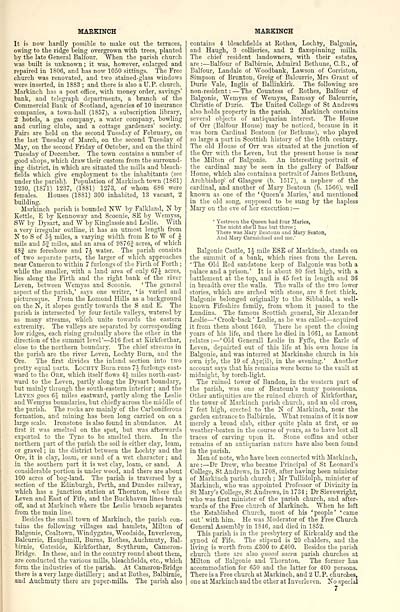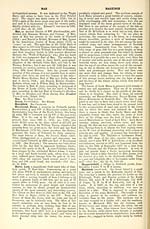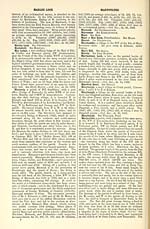Ordnance gazetteer of Scotland > Volume 5
(95) Page 7
Download files
Complete book:
Individual page:
Thumbnail gallery: Grid view | List view

MAEKINCH
It is now hardly possible to make out the terraces,
owing to the ridge being overgrown with trees, planted
by the late General Balfour. When the parish church
was built is unknown ; it was, however, enlarged and
repaired in 1806, and has now 1050 sittings. The Free
church was renovated, and two stained-glass windows
were inserted, in 1883 ; and there is also aU.P. church.
Markinch has a post office, with money order, savings'
bank, and telegraph departments, a branch of the
Commercial Bank of Scotland, agencies of 10 insurance
companies, a town-hall (1857), a subscription library,
2 hotels, a gas company, a water company, bowling
and curling clubs, and a cottage gardeners' society.
Fairs are held on the second Tuesday of February, on
the last Tuesday of March, on the second Tuesday of
May, on the second Friday of October, and on the third
Tuesday of December. The town contains a number of
good shops, which draw their custom from the surround-
ing district, in which are situated the mills and bleach-
fields which give employment to the inhabitants (see
under the parish). Population of JIarkinch town (1861)
1230, (1871) 1237, (1881) 1273, of whom 686 were
females. Houses (1881) 300 inhabited, 13 vacant, 2
building.
Markinch parish is bounded NW by Falkland, N by
Kettle, E by Kennoway and Scoonie, SE by "Wemyss,
SW by Dysart, and W by Kinglassie and Leslie. With
a verj- irregular outline, it has an utmost length from
N to S of 5i miles, a varying width from E to W of J
mile and 5| miles, and an area of 9876 j acres, of which
48| are foreshore and 74 water. The parish consists
of two separate parts, the larger of which approaches
near Cameron to within 7 furlongs of the Firth of Forth ;
while the smaller, -svith a land area of only 67i acres,
lies along the Firth and the right bank of the river
Leven, between AVemyss and Scoonie. ' The general
aspect of the parish, ' says one writer, ' is varied and
picturesque. From the Lomond Hills as a background
on the N, it slopes gently towards the S and E. The
parish is intersected by four fertile valleys, watered by
as man}' streams, which unite towards the eastern
extremity. The valleys are separated by corresponding
low ridges, each rising gradually above the other in the
direction of the summit level' — 516 feet at Kirkforthar,
close to the northern boundary. The chief streams in
the parish are the river Leven, Lochty Burn, and the
Ore. The first divides the inland section into two
pretty equal parts. Lochty Burn runs 7J furlongs east-
ward to the Ore, which itself flows 4| miles north-east-
ward to the Leven, partly along the Dysart boundary,
but mainly through the south-eastern interior ; and the
Leven goes 6i miles eastward, partly along the Leslie
and Wemyss bouudaries, but chiefly across the middle of
the parish. The rocks are mainly of the Carboniferous
formation, and mining has been long carried on on a
large scale. Ironstone is also found in abundance. At
first it was smelted on the spot, but was afterwards
exported to the Tyne to be smelted there. In the
northern part of the parish the soil is either clay, loam,
or gravel ; in the district between the Lochty and the
Ore, it is claj', loam, or sand of a wet character ; and
in the southern part it is wet clay, loam, or sand. A
considerable portion is imder wood, and there are about
100 acres of bog-land. The parish is traversed by a
section of the Edinburgh, Perth, and Dundee railway,
■which has a junction station at Thornton, where the
Leven and East of Fife, and the Buckhaven lines break
off, and at Markinch where the Leslie branch separates
from the main line.
Besides the small town of Markinch, the parish con-
tains the following villages and hamlets, Milton of
Balgonie, Coaltown, Windygates, Woodside, Inverleven,
Balcurrie, Haughmill, Burns, Eothes, Auchmuty, Bal-
birnie, Gateside, Kirkforthar, Scythrum, Cameron-
Bridge. In these, and in the country round about them,
are conducted the various mills, bleachfields, etc. , which
form the industries of the parish. At Cameron-Bridge
there is a very large distillery ; and at Eothes, Balbirnie,
and Auchmuty there are paper-mills. The parish also
MARKINCH
contains 4 bleachfields at Rothes, Lochty, Balgonie,
and Haugh, 3 collieries, and 2 flaxspinning mills.
The chief resident lando^vners, with their estates,
are: — Balfour of Balbirnie, Admiral Bethune, C.B., of
Balfour, Landalo of Woodbank, Lawson of Corriston,
Simpson of Brunton, Grcig of Balcurrie, Mrs Grant of
Durie Vale, Inglis of BaUinkirk. The following are
non-resident: — The Countess of Rothes, Balfour of
Balgonie, Wemyss of Wemyss, Ramsay of Balcurrie,
Christie of Durie. The United College of St Andrews
also holds property in the parish. Markinch contains
several objects of antiquarian interest. The House
of Orr (Balfour House) may be noticed, because in it
was born Cardinal Beatoun (or Bethune), who played
so large a part in Scottish history of the 16th century.
The old House of Orr was situated at the junction of
the Orr with the Leven, but the present house is near
the Milton of Balgonie. An interesting portrait of
the cardinal may be seen in the gallery of Balfour
House, which also contains a portrait of James Bethune,
Archbishop of Glasgow (b. 1517), a nephew of the
cardinal, and another of Mary Beatoun (b. 1566), well
known as one of the 'Queen's Maries,' and mentioned
in the old song, supposed to be sung by the hapless
Mary on the eve of her execution : —
' Yestreen the Queen had four Maries,
The nicht she'll hae but three ;
There was Mar.y Beatoun and Mary Seaton,
And Mary Carmichael and me.'
Balgonie Castle, IJ mile ESE of Markinch, stands on
the summit of a bank, which rises from the Leven.
' The Old Red sandstone keep of Balgonie was both a
palace and a prison.' It is about 80 feet high, with a
battlement at the top, and is 45 feet in length and 36
in breadth over the walls. The walls of the two lower
stories, which are arched with stone, are 8 feet thick.
Balgonie belonged originally to the Sibbalds, a weU-
known Fifeshire famOy, from whom it passed to the
Lundins. The famous Scottish general. Sir Alexander
Leslie — ' Crook-back ' Leslie, as he was called — acquired
it from them about 1640. There he spent the closing
}-ears of his life, and there he died in 1661, as Lament
relates: — 'Old Generall Leslie in Fyfi'e, the Earle of
Leven, depairted out of this life at his own house in
Balgonie, and was interred at Markinshe church in his
own iyle, the 19 of Apr(il), in the evening.' Another
account says that his remains were borne to the vault at
midnight, by torch-light.
The ruined tower of Bandon, in the western part of
the parish, was one of Beatoun's many possessions.
Other antiquities are the ruined church of Kirkforthar,
the tower of Markinch parish church, and an old cross,
7 feet high, erected to the N of Markinch, near the
garden entrance to Balbirnie. What remains of it is now
merely a broad slab, either quite plain at first, or so
weather-beaten in the course of years, as to have lost all
traces of carviug upon it. Stone coffins and other
remains of an antiquarian nature have also been found
in the parish.
Men of note, who have been connected with Markinch,
are :^Dr Drew, who became Principal of St Leonard's
College, St Andrews, in 1708, after having been minister
of Markinch parish church ; Mr Tullidolph, minister of
JIarkinch, who was appointed Professor of Divinity in
St Mary's College, St Andrews, in 1734 ; Dr Sievewright,
who was first minister of the parish church, and after-
wards of the Free church of Markinch. When he left
the Established Chm-ch, most of his ' people ' ' came
out ' with him. He was Moderator of the Free Church
General Assembly in 1846, and died in 1852.
This parish is in the presbytery of Kirkcaldy and the
synod of Fife. The stipend is 20 chalders, and the
living is worth from £300 to £400. Besides the parish
church there are also quoad sacra parish churches at
Milton of Balgonie and Thornton. The former has
accommodation for 650 and the latter for 400 persons.
There is a Free church at Markinch, and 2 U. P. churches,
one at Markinch and the other at Inverleven. No special
It is now hardly possible to make out the terraces,
owing to the ridge being overgrown with trees, planted
by the late General Balfour. When the parish church
was built is unknown ; it was, however, enlarged and
repaired in 1806, and has now 1050 sittings. The Free
church was renovated, and two stained-glass windows
were inserted, in 1883 ; and there is also aU.P. church.
Markinch has a post office, with money order, savings'
bank, and telegraph departments, a branch of the
Commercial Bank of Scotland, agencies of 10 insurance
companies, a town-hall (1857), a subscription library,
2 hotels, a gas company, a water company, bowling
and curling clubs, and a cottage gardeners' society.
Fairs are held on the second Tuesday of February, on
the last Tuesday of March, on the second Tuesday of
May, on the second Friday of October, and on the third
Tuesday of December. The town contains a number of
good shops, which draw their custom from the surround-
ing district, in which are situated the mills and bleach-
fields which give employment to the inhabitants (see
under the parish). Population of JIarkinch town (1861)
1230, (1871) 1237, (1881) 1273, of whom 686 were
females. Houses (1881) 300 inhabited, 13 vacant, 2
building.
Markinch parish is bounded NW by Falkland, N by
Kettle, E by Kennoway and Scoonie, SE by "Wemyss,
SW by Dysart, and W by Kinglassie and Leslie. With
a verj- irregular outline, it has an utmost length from
N to S of 5i miles, a varying width from E to W of J
mile and 5| miles, and an area of 9876 j acres, of which
48| are foreshore and 74 water. The parish consists
of two separate parts, the larger of which approaches
near Cameron to within 7 furlongs of the Firth of Forth ;
while the smaller, -svith a land area of only 67i acres,
lies along the Firth and the right bank of the river
Leven, between AVemyss and Scoonie. ' The general
aspect of the parish, ' says one writer, ' is varied and
picturesque. From the Lomond Hills as a background
on the N, it slopes gently towards the S and E. The
parish is intersected by four fertile valleys, watered by
as man}' streams, which unite towards the eastern
extremity. The valleys are separated by corresponding
low ridges, each rising gradually above the other in the
direction of the summit level' — 516 feet at Kirkforthar,
close to the northern boundary. The chief streams in
the parish are the river Leven, Lochty Burn, and the
Ore. The first divides the inland section into two
pretty equal parts. Lochty Burn runs 7J furlongs east-
ward to the Ore, which itself flows 4| miles north-east-
ward to the Leven, partly along the Dysart boundary,
but mainly through the south-eastern interior ; and the
Leven goes 6i miles eastward, partly along the Leslie
and Wemyss bouudaries, but chiefly across the middle of
the parish. The rocks are mainly of the Carboniferous
formation, and mining has been long carried on on a
large scale. Ironstone is also found in abundance. At
first it was smelted on the spot, but was afterwards
exported to the Tyne to be smelted there. In the
northern part of the parish the soil is either clay, loam,
or gravel ; in the district between the Lochty and the
Ore, it is claj', loam, or sand of a wet character ; and
in the southern part it is wet clay, loam, or sand. A
considerable portion is imder wood, and there are about
100 acres of bog-land. The parish is traversed by a
section of the Edinburgh, Perth, and Dundee railway,
■which has a junction station at Thornton, where the
Leven and East of Fife, and the Buckhaven lines break
off, and at Markinch where the Leslie branch separates
from the main line.
Besides the small town of Markinch, the parish con-
tains the following villages and hamlets, Milton of
Balgonie, Coaltown, Windygates, Woodside, Inverleven,
Balcurrie, Haughmill, Burns, Eothes, Auchmuty, Bal-
birnie, Gateside, Kirkforthar, Scythrum, Cameron-
Bridge. In these, and in the country round about them,
are conducted the various mills, bleachfields, etc. , which
form the industries of the parish. At Cameron-Bridge
there is a very large distillery ; and at Eothes, Balbirnie,
and Auchmuty there are paper-mills. The parish also
MARKINCH
contains 4 bleachfields at Rothes, Lochty, Balgonie,
and Haugh, 3 collieries, and 2 flaxspinning mills.
The chief resident lando^vners, with their estates,
are: — Balfour of Balbirnie, Admiral Bethune, C.B., of
Balfour, Landalo of Woodbank, Lawson of Corriston,
Simpson of Brunton, Grcig of Balcurrie, Mrs Grant of
Durie Vale, Inglis of BaUinkirk. The following are
non-resident: — The Countess of Rothes, Balfour of
Balgonie, Wemyss of Wemyss, Ramsay of Balcurrie,
Christie of Durie. The United College of St Andrews
also holds property in the parish. Markinch contains
several objects of antiquarian interest. The House
of Orr (Balfour House) may be noticed, because in it
was born Cardinal Beatoun (or Bethune), who played
so large a part in Scottish history of the 16th century.
The old House of Orr was situated at the junction of
the Orr with the Leven, but the present house is near
the Milton of Balgonie. An interesting portrait of
the cardinal may be seen in the gallery of Balfour
House, which also contains a portrait of James Bethune,
Archbishop of Glasgow (b. 1517), a nephew of the
cardinal, and another of Mary Beatoun (b. 1566), well
known as one of the 'Queen's Maries,' and mentioned
in the old song, supposed to be sung by the hapless
Mary on the eve of her execution : —
' Yestreen the Queen had four Maries,
The nicht she'll hae but three ;
There was Mar.y Beatoun and Mary Seaton,
And Mary Carmichael and me.'
Balgonie Castle, IJ mile ESE of Markinch, stands on
the summit of a bank, which rises from the Leven.
' The Old Red sandstone keep of Balgonie was both a
palace and a prison.' It is about 80 feet high, with a
battlement at the top, and is 45 feet in length and 36
in breadth over the walls. The walls of the two lower
stories, which are arched with stone, are 8 feet thick.
Balgonie belonged originally to the Sibbalds, a weU-
known Fifeshire famOy, from whom it passed to the
Lundins. The famous Scottish general. Sir Alexander
Leslie — ' Crook-back ' Leslie, as he was called — acquired
it from them about 1640. There he spent the closing
}-ears of his life, and there he died in 1661, as Lament
relates: — 'Old Generall Leslie in Fyfi'e, the Earle of
Leven, depairted out of this life at his own house in
Balgonie, and was interred at Markinshe church in his
own iyle, the 19 of Apr(il), in the evening.' Another
account says that his remains were borne to the vault at
midnight, by torch-light.
The ruined tower of Bandon, in the western part of
the parish, was one of Beatoun's many possessions.
Other antiquities are the ruined church of Kirkforthar,
the tower of Markinch parish church, and an old cross,
7 feet high, erected to the N of Markinch, near the
garden entrance to Balbirnie. What remains of it is now
merely a broad slab, either quite plain at first, or so
weather-beaten in the course of years, as to have lost all
traces of carviug upon it. Stone coffins and other
remains of an antiquarian nature have also been found
in the parish.
Men of note, who have been connected with Markinch,
are :^Dr Drew, who became Principal of St Leonard's
College, St Andrews, in 1708, after having been minister
of Markinch parish church ; Mr Tullidolph, minister of
JIarkinch, who was appointed Professor of Divinity in
St Mary's College, St Andrews, in 1734 ; Dr Sievewright,
who was first minister of the parish church, and after-
wards of the Free church of Markinch. When he left
the Established Chm-ch, most of his ' people ' ' came
out ' with him. He was Moderator of the Free Church
General Assembly in 1846, and died in 1852.
This parish is in the presbytery of Kirkcaldy and the
synod of Fife. The stipend is 20 chalders, and the
living is worth from £300 to £400. Besides the parish
church there are also quoad sacra parish churches at
Milton of Balgonie and Thornton. The former has
accommodation for 650 and the latter for 400 persons.
There is a Free church at Markinch, and 2 U. P. churches,
one at Markinch and the other at Inverleven. No special
Set display mode to: Large image | Transcription
Images and transcriptions on this page, including medium image downloads, may be used under the Creative Commons Attribution 4.0 International Licence unless otherwise stated. ![]()
| Gazetteers of Scotland, 1803-1901 > Ordnance gazetteer of Scotland > Volume 5 > (95) Page 7 |
|---|
| Permanent URL | https://digital.nls.uk/97385090 |
|---|
| Attribution and copyright: |
|
|---|---|

